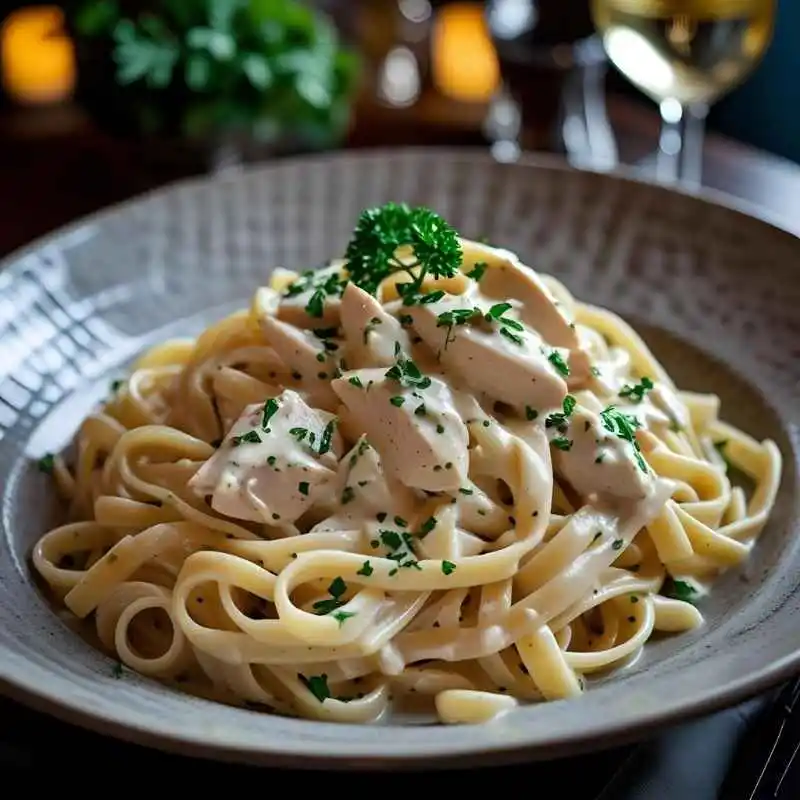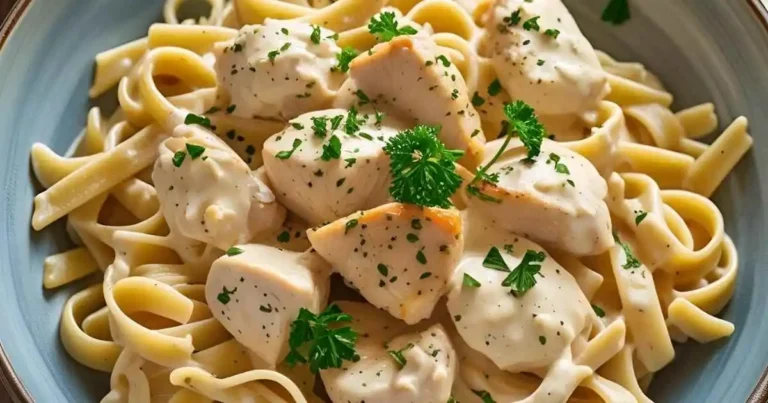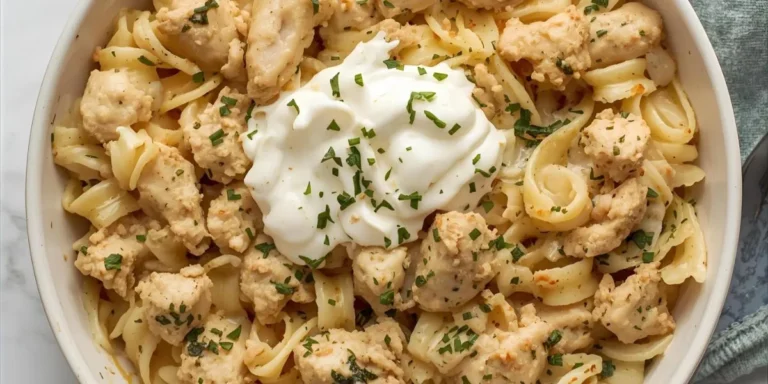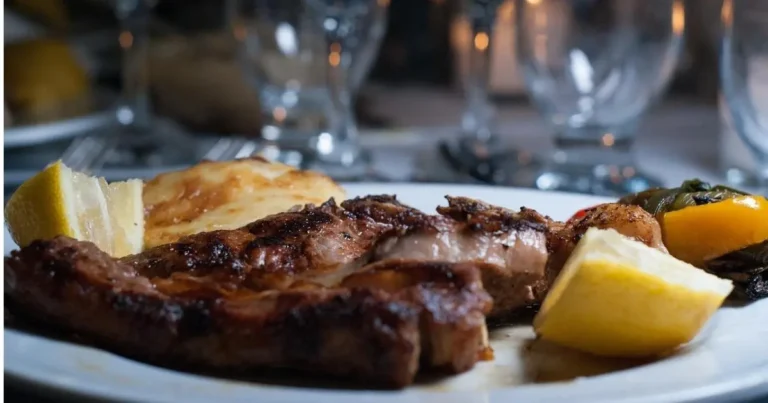Tips and Tricks: How to Make Fettuccine Chicken Alfredo Sauce Like a Pro
Table of Contents
Mastering the art of making Alfredo pasta is a skill every pasta lover should possess. With a few simple ingredients and some expert tips, you can create a rich and creamy fettuccine chicken alfredo sauce that rivals your favorite Italian restaurant.
To make a delicious chicken alfredo recipe, it’s essential to understand the basics of cooking pasta and preparing the sauce. By following this guide, you’ll learn how to cook Alfredo pasta like a pro and impress your family and friends with your culinary skills.
Key Takeaways
- Learn the basics of cooking pasta for a perfect Alfredo dish.
- Discover the secrets to making a rich and creamy alfredo sauce.
- Understand how to combine pasta and sauce for a delicious chicken alfredo recipe.
- Get expert tips on cooking fettuccine to perfection.
- Impress your family and friends with your new culinary skills.
The History and Evolution of Fettuccine Alfredo
As you explore the history of Fettuccine Alfredo, you’ll discover its humble beginnings in Rome and its subsequent evolution. Fettuccine Alfredo is more than just a popular pasta dish; it’s a culinary icon with a rich history that has captivated food enthusiasts worldwide.
Origins in Rome: The Original Recipe
The original Fettuccine Alfredo recipe was born in Rome in the early 20th century. Created by Alfredo Di Lelio in 1908, the dish was initially called “Fettuccine al Burro,” or fettuccine with butter. Di Lelio’s wife, Ines, was recovering from childbirth, and he wanted to create a nourishing, easy-to-digest meal for her. The simple yet rich combination of fettuccine, Parmesan cheese, and butter became an instant hit, not only with his wife but also with the local diners.
American Adaptations: Birth of Chicken Alfredo
As Italian immigrants brought their culinary traditions to the United States, Fettuccine Alfredo underwent a transformation. American adaptations led to the creation of Chicken Alfredo, a variation that added grilled or sautéed chicken to the original recipe. This modification not only enhanced the protein content but also made the dish more substantial and appealing to a broader audience. Today, Chicken Alfredo is a staple in many American-Italian restaurants, and its popularity continues to grow as people learn how to make chicken alfredo at home, often using fettuccine chicken alfredo sauce as a key component.
Essential Ingredients for Authentic Fettuccine Chicken Alfredo Sauce
Crafting an authentic Fettuccine Chicken Alfredo Sauce requires a thoughtful selection of high-quality ingredients. The right components not only elevate the flavor but also ensure a rich and satisfying dining experience.
Selecting the Right Pasta
For an authentic Fettuccine Chicken Alfredo, fettuccine pasta is the obvious choice. Made from egg and flour, this flat, wide noodle is designed to hold onto the creamy Alfredo sauce. When selecting pasta, look for products made from high-quality durum wheat semolina for the best texture and flavor.
Cheese Selection: Parmesan vs. Romano
The type of cheese used can significantly impact the flavor profile of your Alfredo sauce. Parmesan cheese is the traditional choice, offering a nutty, slightly sweet flavor that complements the dish. Romano cheese, on the other hand, adds a tangier, saltier taste. A combination of both can create a rich and complex flavor profile.
Cream, Butter, and Other Dairy Components
The creamy texture of Alfredo sauce is primarily due to butter and heavy cream. The butter adds richness, while the heavy cream contributes to the sauce’s velvety texture. Some recipes also incorporate grated Parmesan for an extra layer of creaminess.
Fresh vs. Dried Herbs and Seasonings
When it comes to seasoning, fresh herbs like parsley and basil can add a bright, fresh flavor. However, dried herbs and spices, such as nutmeg and black pepper, are also essential for depth. Balancing fresh and dried seasonings is key to a well-rounded flavor.
To summarize, the essential ingredients include:
- Fettuccine pasta made from high-quality durum wheat semolina
- A combination of Parmesan and Romano cheese for a complex flavor
- Butter and heavy cream for a rich, creamy sauce
- A balance of fresh and dried herbs for seasoning
By focusing on these key ingredients, you’ll be well on your way to creating a delicious and authentic Fettuccine Chicken Alfredo Sauce that will impress your family and friends.
Kitchen Equipment You’ll Need
The right kitchen equipment can make all the difference in preparing a mouth-watering Fettuccine Chicken Alfredo. To get started, you’ll need a few essential tools and gadgets that will help you cook your pasta to perfection and create a rich, creamy sauce.
Pasta Cooking Essentials
Cooking pasta is a straightforward process, but having the right equipment makes it even easier. You’ll need a large pot to cook your fettuccine. A pot that can hold at least 4 quarts of water is ideal. Additionally, a colander or strainer is necessary for draining the pasta once it’s cooked.
To achieve perfectly cooked pasta, consider using a pasta timer. This tool ensures that your fettuccine is cooked al dente, which is crucial for a great Fettuccine Chicken Alfredo.
Sauce-Making Tools and Equipment
Making the Alfredo sauce requires some specific tools. A medium saucepan is essential for heating your sauce ingredients. You’ll also need a whisk or silicone spatula to mix the sauce thoroughly, ensuring it’s smooth and creamy.
For a more refined sauce, consider using an immersion blender. This tool can help you achieve a silky texture by blending the sauce right in the pan.
Time-Saving Equipment Options
To streamline your cooking process, consider using a stand mixer or food processor to grate your Parmesan cheese quickly. You can also use a microwave-safe bowl to melt butter or heat small amounts of sauce, saving you time and effort.
| Equipment | Purpose |
|---|---|
| Large Pot | Cooking Fettuccine |
| Colander or Strainer | Draining Pasta |
| Pasta Timer | Timing Pasta Cooking |
| Medium Saucepan | Heating Sauce Ingredients |
| Whisk or Silicone Spatula | Mixing Sauce |
| Immersion Blender | Blending Sauce for Texture |
| Stand Mixer or Food Processor | Grate Parmesan Cheese |
| Microwave-Safe Bowl | Melting Butter or Heating Sauce |
How to Season Chicken for Alfredo Perfectly
To make chicken Alfredo that’s truly exceptional, you need to start with perfectly seasoned chicken. The right seasoning can elevate the dish, making it more flavorful and enjoyable. In this section, we’ll explore the best practices for seasoning chicken, including marinade options, herb and spice combinations, and cooking methods that ensure juicy, tender chicken.
Marinade Options for Maximum Flavor
A good marinade can add depth and complexity to your chicken. For chicken Alfredo, consider using a marinade that includes ingredients like olive oil, lemon juice, garlic, and herbs such as thyme or rosemary. The acidity in the lemon juice helps to tenderize the chicken, while the herbs add a fresh, aromatic flavor. You can also experiment with different types of vinegar or yogurt-based marinades for varied effects.
Herb and Spice Combinations
The right combination of herbs and spices can make your chicken Alfredo stand out. Classic choices include paprika, garlic powder, and Italian seasoning. For a bit of heat, you can add red pepper flakes or cayenne pepper. Don’t forget to season with salt and black pepper, as these enhance the overall flavor. Experimenting with different combinations can help you find the perfect taste for your Alfredo dish.
Cooking Methods for Juicy Chicken


Cooking the chicken correctly is just as important as seasoning it. Grilling or pan-searing the chicken can add a nice char on the outside while keeping the inside juicy. If you prefer a more straightforward approach, baking is a good option. Regardless of the method, make sure to cook the chicken until it reaches an internal temperature of 165°F to ensure food safety.
Pre-Seasoning Tips and Timing
The timing of your seasoning can impact the final flavor. Ideally, you should season the chicken at least 30 minutes before cooking to allow the flavors to penetrate the meat. If you’re using a marinade, plan ahead as it can take several hours or even overnight to achieve the best results. Remember, the key to perfectly seasoned chicken is patience and attention to detail.
Mastering the Perfect Pasta Texture
Mastering pasta texture is a skill that elevates your Alfredo dish from good to great. Achieving the perfect texture is not just about following a recipe; it’s about understanding the nuances of pasta cooking.
The Al Dente Secret
Cooking pasta al dente is crucial for a great Alfredo. Al dente, which translates to “to the tooth,” means the pasta should have a slight firmness when bitten into. This texture provides a better base for the creamy Alfredo sauce to cling to, ensuring each bite is balanced and satisfying.
To achieve al dente, monitor your pasta’s cooking time closely. Typically, it’s best to check for doneness a minute or two before the package’s recommended cooking time. Use a fork or slotted spoon to taste a piece; it should be slightly resistant to the bite but not hard.
Pasta Water: The Chef’s Secret Ingredient
One often overlooked aspect of cooking pasta is reserving some of the pasta water before draining. This water, rich in starch, is a chef’s secret ingredient that can make or break your Alfredo sauce. Adding a bit of pasta water to your sauce can help achieve the perfect consistency, making it creamy and ensuring it coats the pasta evenly.
The starchy pasta water acts as an emulsifier, helping to bind the sauce ingredients together. Start with a small amount (about 1/4 cup) and adjust as needed to avoid a sauce that’s too thin.
Timing Your Pasta with Your Sauce
Timing is everything when it comes to combining pasta and sauce. Ideally, your pasta should be done cooking just as your sauce is nearing completion. This synchronization ensures that the pasta doesn’t sit for too long, becoming soggy or sticking together.
To achieve this, plan your cooking process so that the pasta and sauce finish at the same time. If your sauce is ready before your pasta, keep it warm on low heat, stirring occasionally, until your pasta is al dente and ready to be combined.
Step-by-Step Guide to Perfect Fettuccine Chicken Alfredo Sauce
Making the perfect Fettuccine Chicken Alfredo Sauce is a culinary skill that requires attention to detail and a bit of practice. To create a dish that rivals your favorite Italian restaurant, you need to master the sauce. In this guide, we will walk you through the process of making a rich and creamy Fettuccine Chicken Alfredo Sauce.
Building Your Base: Starting the Sauce
The foundation of a great Fettuccine Chicken Alfredo Sauce starts with high-quality ingredients. Begin by melting 2 tablespoons of butter in a large skillet over medium heat. Once melted, add 1 cup of heavy cream and stir until it starts to simmer. The key is to heat the cream gradually to prevent it from boiling over.
Next, incorporate 1 cup of grated Parmesan cheese. It’s essential to use freshly grated Parmesan for the best flavor. Stir the cheese into the cream until it’s fully melted and the sauce is smooth. You can also add a pinch of salt and a grind of black pepper to enhance the flavor.
| Ingredient | Quantity | Purpose |
|---|---|---|
| Butter | 2 tablespoons | Base for the sauce |
| Heavy Cream | 1 cup | Adds richness and creaminess |
| Parmesan Cheese | 1 cup, grated | Provides a salty, nutty flavor |
The Proper Technique for Sauce Consistency
Achieving the right consistency is crucial for Fettuccine Chicken Alfredo Sauce. The sauce should be creamy but not too thick. To adjust the consistency, you can add more heavy cream if it’s too thick or simmer it for a few more minutes if it’s too thin.
To ensure your sauce coats the pasta evenly, it’s essential to stir constantly, especially when adding the cheese. Using a low heat helps prevent the sauce from breaking and ensures a smooth texture.
Troubleshooting Common Sauce Problems
Even with careful preparation, issues can arise. If your sauce separates, it might be due to high heat or insufficient stirring. To fix this, remove it from the heat and whisk vigorously. If it’s too thick, a small addition of heavy cream can help.
Another common issue is a sauce that’s too grainy. This can be caused by not fully melting the cheese. To avoid this, make sure to stir constantly and use a gentle heat.
By following these steps and tips, you’ll be able to create a delicious Fettuccine Chicken Alfredo Sauce that’s sure to impress. Whether you’re cooking for a special occasion or a weeknight dinner, mastering this sauce will elevate your culinary skills.
Combining Pasta, Chicken, and Sauce Like a Professional
The final step in creating an unforgettable Fettuccine Chicken Alfredo lies in harmoniously combining the pasta, chicken, and sauce. This crucial phase requires attention to detail and a bit of finesse to ensure that each component complements the others perfectly.
Timing and Coordination
Timing is everything when it comes to combining your pasta, chicken, and sauce. Ideally, you want to cook your fettuccine and chicken so that they finish at the same time as your sauce is ready. This synchronization ensures that the pasta is still al dente, the chicken is juicy, and the sauce is creamy and hot. To achieve this, start cooking your pasta a few minutes before you finish your sauce, and have your chicken ready to be tossed in at the last minute.
Proper Mixing Techniques
The way you mix your pasta, chicken, and sauce can significantly impact the dish’s overall quality. Use a large, shallow skillet or saucepan to combine the elements, as this allows for better distribution of the sauce. Gently toss the cooked fettuccine in the Alfredo sauce until the pasta is well coated, then add the seasoned chicken and continue to toss until everything is harmoniously combined. Be gentle to avoid breaking the pasta or shredding the chicken.
Final Adjustments Before Serving
Before serving, take a moment to adjust the seasoning of your Fettuccine Chicken Alfredo. Taste and add salt, pepper, or additional herbs if needed. If the sauce has thickened too much, a little pasta water can be added to achieve the desired consistency. Finally, garnish with parsley or thyme for a fresh touch and a sprinkle of Parmesan cheese for added depth of flavor.
Reheating Tips for Leftovers
If you have leftovers, reheating your Fettuccine Chicken Alfredo requires some care to maintain its creamy texture. Reheat the dish over low heat, adding a splash of milk or cream to loosen the sauce. Stir constantly to prevent the sauce from breaking or the pasta from becoming mushy. This simple technique will help you enjoy your Chicken Alfredo leftovers as if they were freshly made.
Common Mistakes to Avoid When Making Chicken Alfredo
Chicken Alfredo, a dish beloved by many, can quickly turn from a culinary delight to a kitchen disaster if certain mistakes are not avoided. To ensure a delicious outcome, it’s essential to be aware of the common pitfalls that can affect the quality of your dish.
Sauce Separation Issues
One of the most common issues with Chicken Alfredo is sauce separation. This occurs when the sauce doesn’t emulsify properly, resulting in an unappealing oily or curdled texture. To avoid this, use high-quality Parmesan cheese that is freshly grated, as it contains the necessary fats and proteins to help stabilize the sauce. Additionally, avoid overheating the sauce, as this can cause the butter and cream to separate.
Overcooked Pasta Problems
Overcooking pasta is another mistake that can ruin your Chicken Alfredo. Al dente pasta is crucial, as it provides a satisfying texture that complements the creamy sauce. To achieve this, cook your fettuccine until it’s just shy of being fully cooked, then reserve some pasta water before draining. This water can later be used to adjust the sauce’s consistency.
| Pasta Texture | Cooking Time | Result |
|---|---|---|
| Al Dente | 8-10 minutes | Firm but yielding to bite |
| Overcooked | 12+ minutes | Mushy and unappetizing |
Chicken Texture Mishaps
The texture of the chicken is just as important as the pasta and sauce. To avoid tough or dry chicken, don’t overcook it. Use a thermometer to ensure the chicken reaches a safe internal temperature of 165°F (74°C). Letting the chicken rest for a few minutes before slicing can also help retain its juices.
Seasoning Balance Errors
Finally, achieving a balanced seasoning is crucial. Taste your dish as you go and adjust the seasoning accordingly. A well-balanced Chicken Alfredo should have a harmony of salty, savory, and slightly sweet flavors. Be cautious not to overseason, as this can overpower the dish.
By being mindful of these common mistakes, you can create a Chicken Alfredo that is not only delicious but also visually appealing. With practice and patience, you’ll master the art of making this beloved dish.
Conclusion: Your Path to Alfredo Perfection
Now that you’ve learned the intricacies of crafting the perfect fettuccine chicken alfredo sauce and chicken alfredo recipe, it’s time to put your skills into practice. By mastering the techniques outlined in this article, you’ll be well on your way to creating a dish that’s sure to impress.
Remember, the key to a great chicken alfredo recipe lies in the quality of your ingredients and your attention to detail. With practice, you’ll become more comfortable with the process, and your fettuccine chicken alfredo sauce will become a staple in your culinary repertoire.
As you continue to refine your skills, don’t be afraid to experiment with new ingredients and techniques. The world of pasta is vast, and there’s always room for creativity and innovation. With patience and persistence, you’ll be creating delicious fettuccine chicken alfredo sauce like a pro in no time.
FAQ
What is the best type of pasta to use for chicken alfredo?
Fettuccine is the traditional and most recommended pasta for chicken alfredo due to its flat, wide noodles that hold onto the creamy sauce well.
How do I prevent my alfredo sauce from separating?
To prevent sauce separation, ensure you’re using high-quality ingredients, and avoid overheating the sauce. Stir constantly when adding dairy, and consider tempering the hot pasta water into the sauce before combining.
Can I make chicken alfredo without heavy cream?
Yes, you can make a lighter version of chicken alfredo by substituting heavy cream with alternatives like half-and-half, Greek yogurt, or a mixture of milk and flour as a thickener, though the richness may vary.
How do I season chicken for alfredo?
Season chicken for alfredo by marinating it in a mix of olive oil, garlic, herbs like parsley and thyme, salt, and pepper before cooking. You can also sprinkle paprika, Italian seasoning, or dried herbs directly onto the chicken for added flavor.
What are some common mistakes when making chicken alfredo?
Common mistakes include overcooking the pasta, not cooking the chicken to the right doneness, using low-quality cheese, and not achieving the right sauce consistency, which can lead to a separated or too thick sauce.
How can I achieve the perfect al dente texture for my pasta?
To achieve al dente pasta, cook it in boiling, salted water until it still has a bit of bite or chew. Check the package instructions for the recommended cooking time, and test the pasta a minute or two before it’s supposed to be done.
Can I make chicken alfredo ahead of time?
While you can prepare components ahead of time, such as cooking the chicken and making the sauce, it’s best to combine and serve chicken alfredo fresh to maintain the best texture and flavor. Reheating can be done, but be cautious of overcooking.
Enjoyed the recipes? We’d love to hear your honest thoughts!😊
There are no reviews yet. Be the first one to write one.







